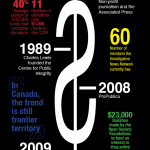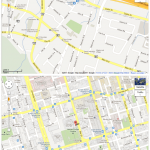Say Word Keeps Kids Out of Trouble and Interested in Journalism
A magazine by and for young people, Say Word de-bunks negative stereotypes of a community while helping at-risk kids—and maybe nurturing a new generation of journalists
Even though it’s Saturday morning, the staff of Say Word is busy running a casting call for the next issue’s fashion spread. Young people scatter around an office on the third floor of a grey commercial building. Anita Singh stations herself at the entrance, greeting models; Tevin Thompson sets up the camera and lights for the test shots; and Priya Ramanujam uploads “behind the scene” videos to the lifestyle magazine’s YouTube channel. By 5 p.m., when the exit meeting brings the whole group to one table, it’s been a full day’s work, on the weekend, when Say Word’s masthead takes over the offices of East Metro Youth Services to put together a magazine by and for the young people of Scarborough.
The staff mirrors the diversity of the neighbourhood in a way that mainstream journalism in Canada still doesn’t after decades of debate, initiatives and policies that haven’t really changed the make-up of the newsroom. “One of the reasons Say Word started was to help young people from more diverse backgrounds get into media,” says Priya Ramanujam, the 28-year-old coordinator. The program receives funding as an anti-violence initiative and offers a way for young people to address weaknesses in the coverage of their neighbourhood, but there’s no guarantee that it will lead to more diversity in newsrooms anytime soon.
After four people were shot in three drive-by shootings in the Malvern area within two weeks in the beginning of 2004, the area became synonymous in the media with gang violence. In April of that year, then-Governor General Adrienne Clarkson visited Malvern and publicly shamed journalists for shallow, stereotypical reporting. Ramanujam’s internship at the Toronto Star began that summer and the newspaper asked her to vet stories about her neighbourhood for negative stereotyping.
Most of Say Word’s articles have nothing to do with violence, but the tone of the magazine is young and positive. Articles about fashion, relationship advice and up-and-coming rappers from Scarborough are in the mix along with pieces about school uniforms, an all-women theatre troupe and models of colour in a mostly white fashion world. On the inside cover of the 2010 issue, a black man wearing glasses and a prison shirt holds up a book and looks straight at the reader; the message beside his head reads, “Maybe violence isn’t the answer, genius!”
At the community level, there’s no shortage of young people with culturally, socio-economically and ethnically diverse backgrounds interested in journalism and programs for young people have been running in Canada since at least 1990, when Regent Park Focus Youth Media Arts Centre started its own magazine and community radio. Leave Out Violence runs programs across the continent. But there’s been little collaboration between these organizations and the news outlets, or even journalism schools, perhaps because of resentment and distrust on both sides. In the summer of 2010, the Say Word masthead spent a week at Ryerson University, participating in workshops, meeting journalists and professors, and producing stories, many on the G20 riots enveloping downtown Toronto. But that program couldn’t get funding this summer.
Diversity is a journalism buzzword, but a 2004 study by John Miller at Ryerson showed that non-white people made up just 3.4 percent of newsroom staff, up from 2.6 percent in 1994. Twenty-two papers had an all-white staff. When a newspaper did try to improve its diversity, the big motivation was complaints about coverage. A 2010 study, which looked at news managers, directors and broadcast reporters, showed similar under-representation, with one exception: about 20 percent of TV anchors and reporters come from visible minority groups.
Renato Zane, vice president and general manager of Citytv Vancouver and OMNI BC, has worked with the Radio Television Digital News Association on its newsroom diversity project. “We are so caught up in our day-to-day that we often don’t think of the staff that we might need in the future,” he says. “I think there’s a role to play in sort of nation-building, multiculturalism and making a country better, but it’s easier said than done.“ He’d like to see more programs that bridge the divide between community projects and professional journalism and take advantage of both groups’ strengths. “So you do two things: you’re improving your product but at the same time you’re finding new talent.” With a tightening newsroom budget and a 24-hour news cycle, though, there’s less time than ever for taking risks on unproven reporters.
Meanwhile, the “new talent” is working on the latest issue of Say Word. Anita Singh, a first-year corporate media production student, has volunteered at several community radio stations, a satellite radio station, and now writes for Broken Pencil. The 21-year-old joined the magazine to learn more about print media, and says it’s a more supportive atmosphere than school, where “people are trying to subliminally rip each other” to seem like the best student. Singh is now the layout designer and will learn InDesign. And Thompson, though he’s just 15, says the program is good for his resume. His interest is in photography and although he “already graduated” from the magazine last year, he still comes to all three sessions a week and helps edit the fashion section.
But some people here are doing more than gaining valuable experience. Kareem Gordon is a New York City transplant and a student at Centennial College. The 21-year-old edits the community section of the magazine, and is learning video and photography on Tuesdays. K.G., as he’s known, is clearly the comedian of the group, but hinted that his life wasn’t as easy as his jokes. “I never would think that this place would be something I would come to, and I feel that more youth should keep coming here,” he says. “Because it’s something to keep you out of trouble, and occupy you, with people you can relate to.”
Ramanujam goes beyond classroom recruitment to find people who might not think they belong in a journalism program, especially youth who’ve dropped out of school or are caught in the justice system. The challenges many of them face became apparent in the exit meeting. Two were absent—one had “very serious personal issues” and the other had to spend his weekends in jail for a few months. Both sent apologies and promised to return; everyone at the table voted to have them back. In a real newsroom, second chances are hard to come by, but for some people, even a first chance is a long shot.














